Education Technologies
The issue of education in many countries is an edge - Russia is no exception. I will say even more - innovative educational developments in our country can be counted on the fingers of one hand. Even if someone comes up with something, it will not be implemented right away.

Well, let's at least then see what others are doing in this regard ... on the example of Great Britain, where the thematic exhibition BETT 2010 recently took place. Oh, is it really about the future of our children? )
According to the organizers, the BETT (British Educational Training and Technology Show) is the largest educational exhibition on the planet (the exhibition area occupied more than 35 thousand square meters). Well, if you don’t have any other information, you’ll have to believe them) Almost everything that was presented at the exhibition mostly concerns education in Great Britain, but it was about general issues concerning education all over the world.
')

One of the most interesting seminars was Professor Sugata Mitra from the University of Newcastle and Professor Gilley Salmon from Leicester. It dealt with “cloud groups” - by analogy with “cloud computing,” two professors who met at a conference a year ago and found a lot in common in their ideas, conceived to create decentralized groups of enthusiasts engaged in basic education using electronic means places where traditional education is not available - in developing countries, poor areas of rich cities and so on.

Professor Mitra believes that groups of children who have access to a computer are capable of self-organization. As an example, he cites an astounding (but, according to him, typical) case. Professor Mitra installed a computer in a protected building in a coastal Tamil village, recently destroyed by a typhoon. English lessons (which local children of the fishermen did not know) were downloaded to the computer and, as an experiment, materials on genetics, DNA sequencing, etc. I don’t know about all the intricacies of organizing such a stand, but returning two months later, the professor found out to his surprise that the children had mastered English, studied the materials on genetics and understood their complete uselessness in everyday life, and complained to the professor.
Another important factor both speakers call the figure of "spiritual leader", which can be almost any charismatic person. For example, in one of the seminars they talked about Anthony Mullen , a policeman from New York with twenty years of experience. Mullen, who had been engaged in difficult teenagers for many years, some time ago turned into a school teacher, and in the teaching field he achieved a staggering success: last spring, President Obama presented him with the "Teacher of the Year" award.

The performance of Mullen involuntarily reminded the film “Kindergarten Policeman”, but on the whole it came down to what the British professors were talking about - children need first of all authority, for which they can follow knowledge, and without such authority no information technology will help the educational process. However, where the educational process is established, information technologies work wonders - or, at least, greatly contribute to the cause.
The work of Neil Choo Hong from Edinburgh is interesting - he works at the EPCC High Performance Computing Center and deals with their problems. In addition to the presented programs that allow to apply calculations for climate modeling and carry out synthesis / analysis of various chemical compounds, Neil surprised those present with a climate map ... built on messages from Twitter! :)
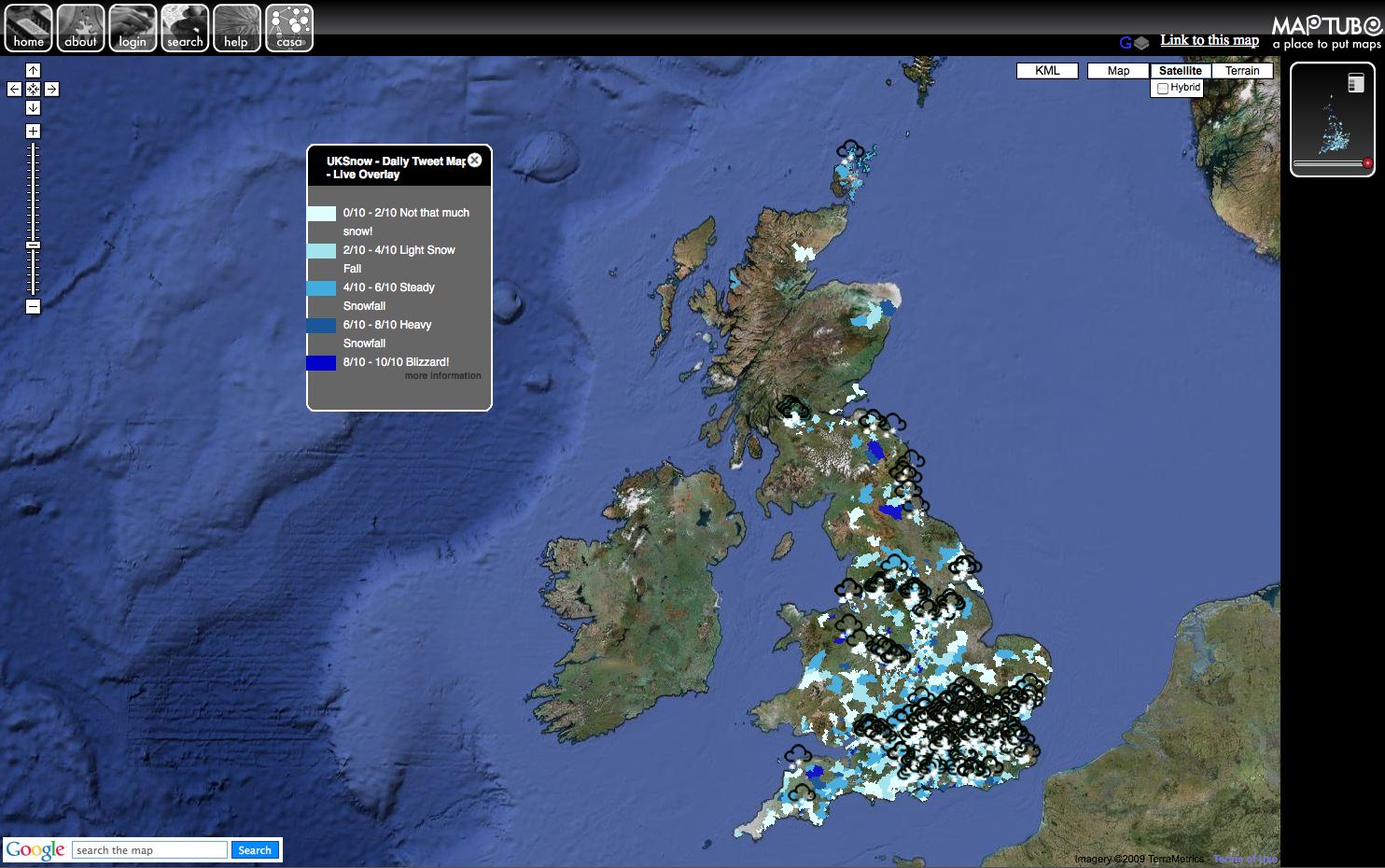
The principle of the card is simple and elegant: the snow in the United Kingdom is infrequent, so users from all over the UK actively “chirp” whenever it does fall - after all, what about tweeting in the UK is not about the weather) Accordingly, all statements on the key “snow” are easily and simply aggregated and distributed across a single map of the country. And you say Twitter is a useless thing! )
Not at the exhibition and without the participation of Intel. Under the roof of the huge exhibition complex "Olympia", where the event was held, the company introduced a device for reading - Intel Reader . No, this is not “another reader”, this is a full-fledged synthesizer!

True, it is not designed for the mass market, but only for blind and visually impaired people. The device is built on an Intel Atom processor and has a 5 megapixel camera on board. We open the book (magazine / newspaper / ...), take a picture and ... and after a few seconds the reader is ready to read what was written out loud. Working with focal lengths in the range of 10 cm to one meter and having the ability to be mounted in a special docking station, the device is able to “read” even the largest printed materials, up to and including books.

Inside the device, 4GB of flash memory is installed and up to 600 re-open pages (or half a million pages of pure text) are freely stored. The reader can create MP3-files that can be transferred to a portable player and take with you on the road.
The inventor of the reader is the employee of Intel Ben Foss, who has suffered from dyslexia since childhood - it is difficult for dyslexics to read the text, and far from all the literature is in the audiobook format. “ As a representative of the dyslexic community, it is extremely pleasant for me to help the same, as I do, for people who find it difficult to cope with printed text. Intel Reader helps dyslexics, the visually impaired and blind to read any texts of interest to them at school, at work and in the big world . ” While the basic language is still English, other languages may appear over time, but to recognize the Russian language you will have to write a Cyrillic module, and this is a separate task.
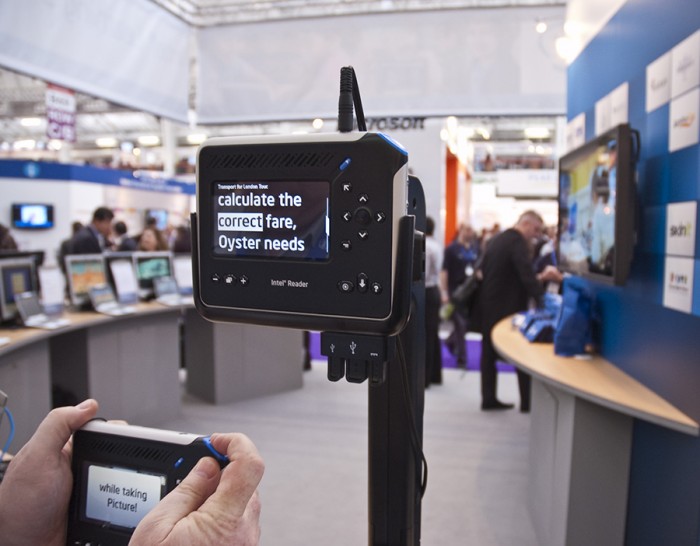
The price of the novelty is embarrassing - $ 1500, but against the background of Braille devices, which can cost several times more, this minus seems like a half plus. On the other hand, a start has been made and, possibly, not only cameras, but also simple mobile phones will soon “begin talking”.
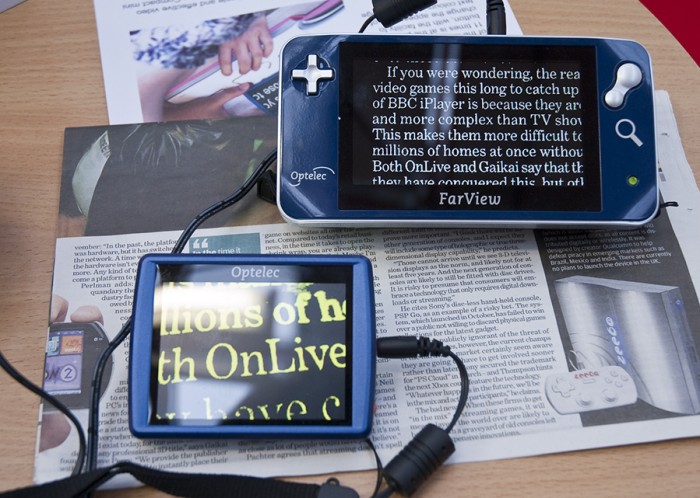
Intel Reader's closest competitor is a device called FarView - it is smaller, lighter, it has more megapixels and it is five times cheaper; can distinguish typographic marks and make them more contrast. However, Optelec devices lack a recognizing filling and speech synthesizer - rather, they are more sophisticated reading glasses, suitable for the visually impaired, but useless for people with blindness or serious visual problems.
As a young father, I was surprised by the “class of the future” according to Panasonic, which was presented at the exhibition. Well, it would be an interactive board and individual computers - it seems that this can not be avoided. But here the teacher’s workplace is somewhat alarming:
The cameras with which the class is equipped, in real time, “monitor” the pupils — they recognize their faces (and even emotions), signal when the child has turned away or raised his hand to respond ...
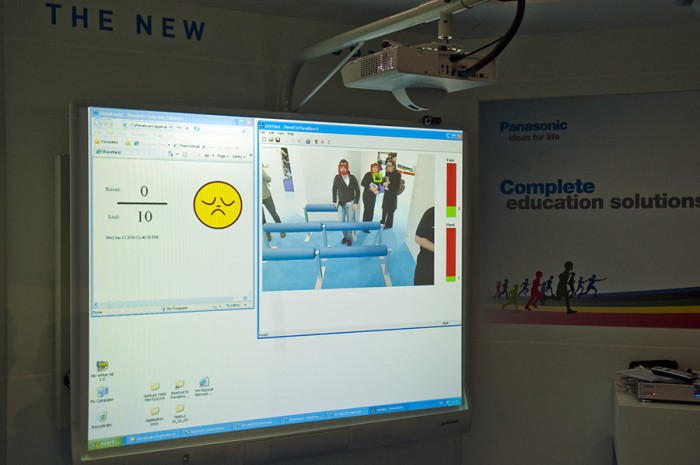

Sensors of volume and movement, remote blocking of the room and recording of incoming and outgoing students, a speakerphone - all this is done through a small fifty-gram “whistle” that the teacher wears around his neck:
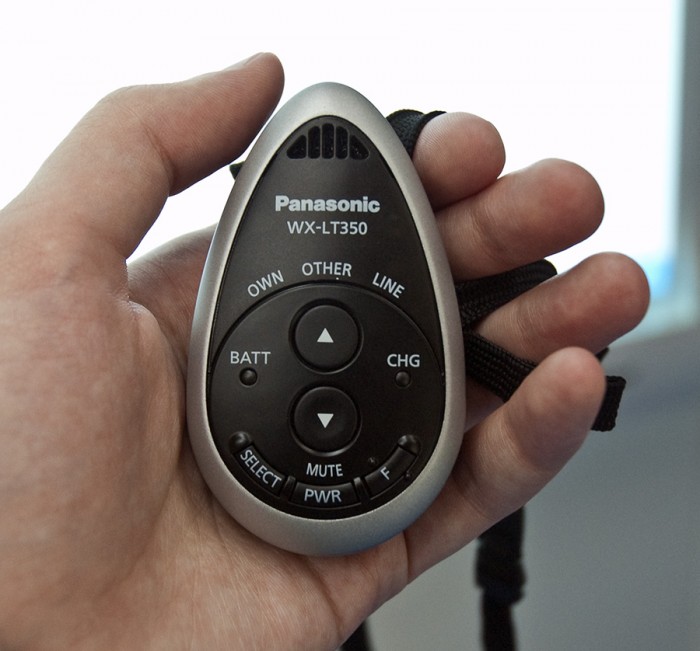
I do not understand how we could have done without it before ?! ) IMHO, it looks more like a high-tech children's prison ... well, well, their business is to offer, our business is to refuse)
Unimat is engaged in the production of various “machine tools”, thanks to which labor lessons in the future may look like this:
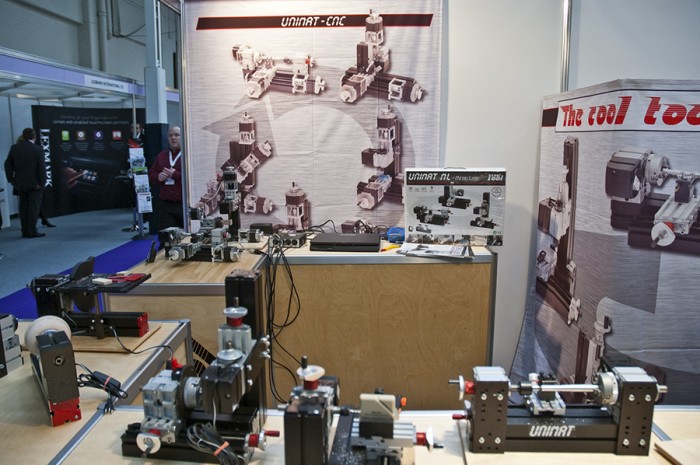
The same turning and milling machines, only reduced. Accordingly, CNC controls more than students ... but it will definitely arouse interest in adolescents, as well as contribute to reducing the level of injury.

One of the most ambitious expositions at the exhibition was held without a demonstration stand. Unlocking Archives is a project to digitize and upload to the Internet three large British national archives. To assess the scale, imagine that the entire archive of the Gosfilmofond suddenly began to digitize and upload online - this is invaluable material for any textbooks on history, art, music and cinema!

Eh, if domestic museums and archives would get the same excellent managerial staff and finances as the National Archives of Great Britain and the British Institute of Cinematography have - you see, all the talk about “digital heritage” would be realized in the fastest and most beautiful way.
The exhibition itself took several days and, in addition to seminars and reports, there were many interesting things in it. Conventionally, everything presented can be divided into two large groups: gadgets (interactive boards, projectors, furniture, etc.) and solutions (various services, software, training courses, etc.).
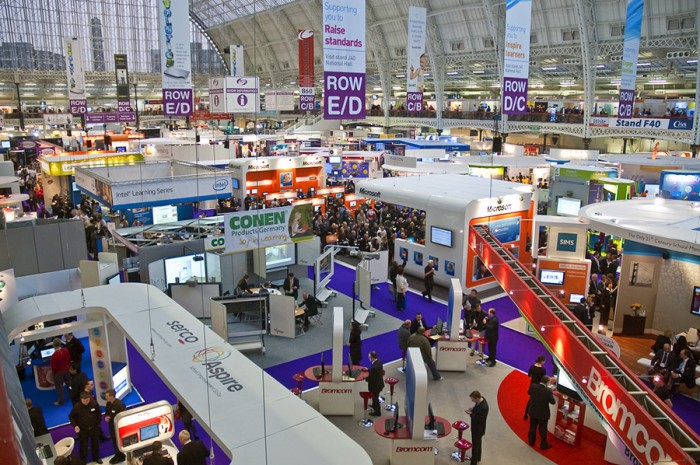
A huge number of solutions for three-dimensional images were presented, as well as various interactive whiteboards — projection and plasma-based, projected onto the wall and tracking touches with additional sensors and using special Bluetooth markers, ceramic and plastic ... in short, any)
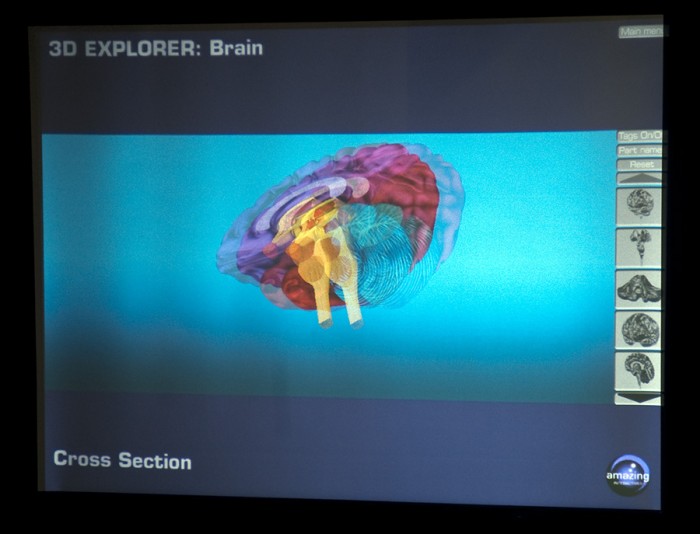

And everything seems to be beautiful, but ... software for such devices looks simply monstrous. Almost everywhere. Sometimes it even seems that there is only a desire to “make students comfortable and beautiful” without an understanding of the real school needs and without having an idea of how students should deal with all this. So while all the software is more like a wild cross between a Word and Photoshop, written by government order by stern hackers from defense institutions. Although there are “very nothing” programs, like, for example, on the Hitachi stand (pay attention to the localization):

Nevertheless, already now similar devices are delivered to Russia literally by cars (although a couple of years ago they really did not know anything about them).
Returning to Intel, they also had their own booth, where they paid a lot of attention to the ClassMatePC devices (a school netbook, a review of which I already did ). Judging by the number of partners, the device is really interested in many.

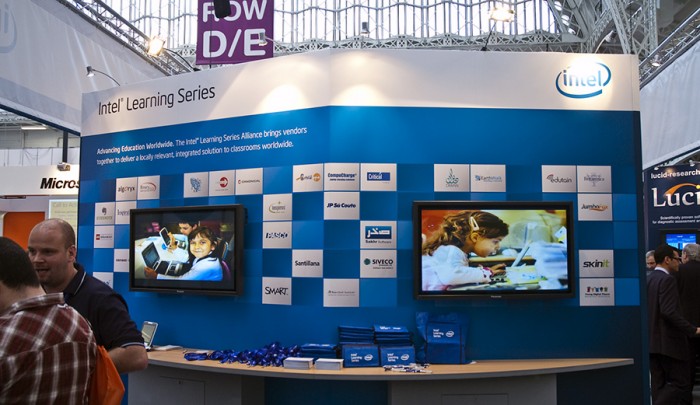
For example, this is the result of the cooperation between Intel and Lego - from a conventional designer you can assemble quite complex mechanisms that will be controlled by special CMPC visual software, from which a child can easily learn the basics of programming:
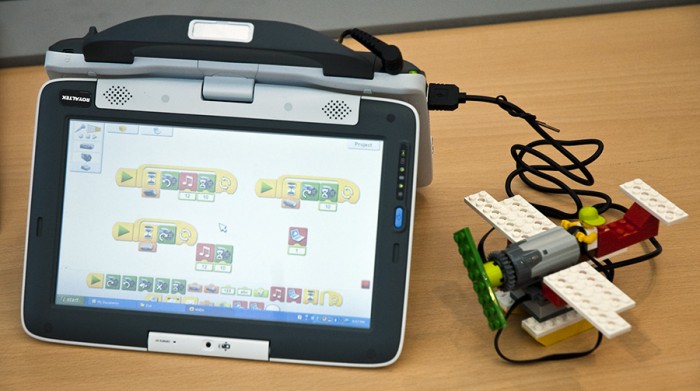

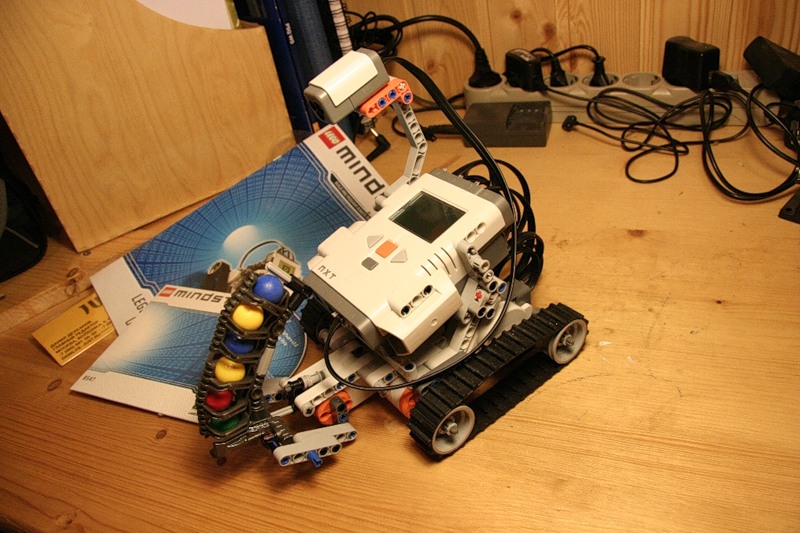
However, a couple of words have already been said about such a robot;)
Pasco employees showed Pasport - a sensor system (electrical, temperature, gravitational sensors) that USB connects to CMPC and helps children learn the basics of physics, chemistry and other natural sciences - Pasport devices can be selected for specific tasks.
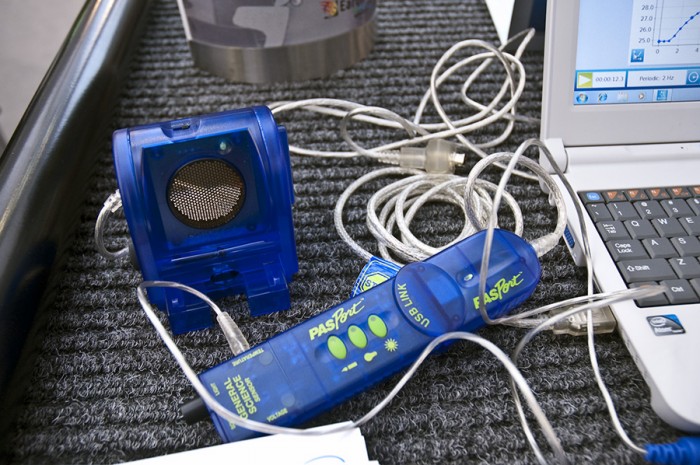
As testers at the exhibition, there were real (!) Children who mastered the novelties and, at the end of the work, made their first multimedia (video and audio) reports on what they saw:
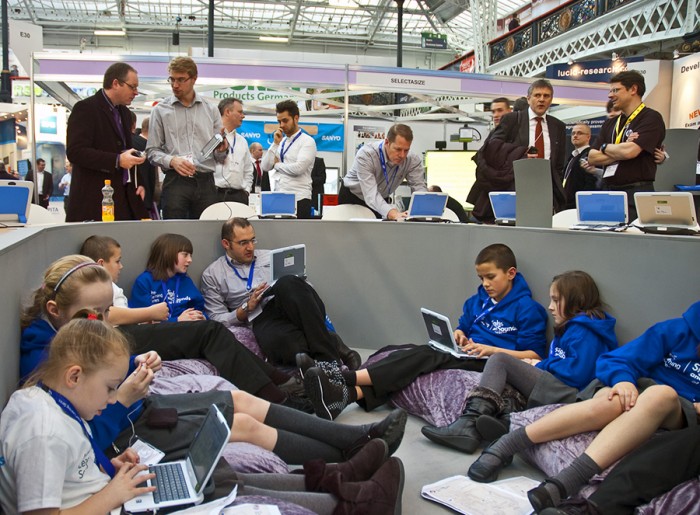
Everything that happened could be observed on an interactive whiteboard - in principle, something like this is seen by a teacher in a classroom equipped with ClassMate PC:
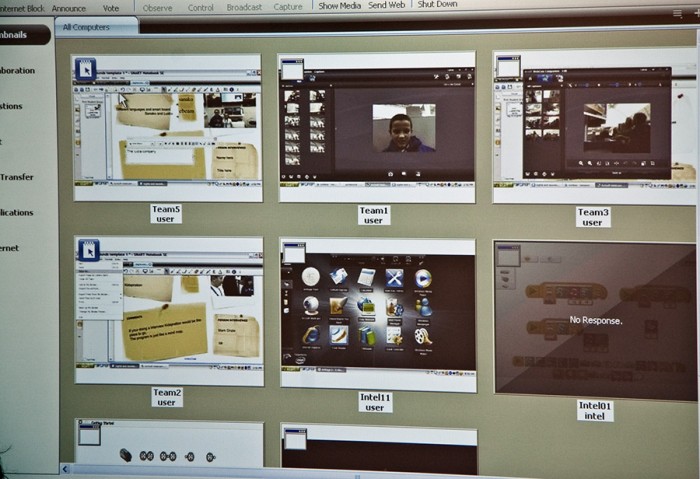
As you can see, technology and technology are not standing still and there will only be more. It remains only to wish that the manufacturers of electronics and educational software developers have the same level of synergy as Intel and its partners - you see, our children will indeed heal the way we saw it in our most positive ideas)
Source :: Twitter
Successes!

Well, let's at least then see what others are doing in this regard ... on the example of Great Britain, where the thematic exhibition BETT 2010 recently took place. Oh, is it really about the future of our children? )
According to the organizers, the BETT (British Educational Training and Technology Show) is the largest educational exhibition on the planet (the exhibition area occupied more than 35 thousand square meters). Well, if you don’t have any other information, you’ll have to believe them) Almost everything that was presented at the exhibition mostly concerns education in Great Britain, but it was about general issues concerning education all over the world.
')

One of the most interesting seminars was Professor Sugata Mitra from the University of Newcastle and Professor Gilley Salmon from Leicester. It dealt with “cloud groups” - by analogy with “cloud computing,” two professors who met at a conference a year ago and found a lot in common in their ideas, conceived to create decentralized groups of enthusiasts engaged in basic education using electronic means places where traditional education is not available - in developing countries, poor areas of rich cities and so on.

Professor Mitra believes that groups of children who have access to a computer are capable of self-organization. As an example, he cites an astounding (but, according to him, typical) case. Professor Mitra installed a computer in a protected building in a coastal Tamil village, recently destroyed by a typhoon. English lessons (which local children of the fishermen did not know) were downloaded to the computer and, as an experiment, materials on genetics, DNA sequencing, etc. I don’t know about all the intricacies of organizing such a stand, but returning two months later, the professor found out to his surprise that the children had mastered English, studied the materials on genetics and understood their complete uselessness in everyday life, and complained to the professor.
Kindergarten cop
Another important factor both speakers call the figure of "spiritual leader", which can be almost any charismatic person. For example, in one of the seminars they talked about Anthony Mullen , a policeman from New York with twenty years of experience. Mullen, who had been engaged in difficult teenagers for many years, some time ago turned into a school teacher, and in the teaching field he achieved a staggering success: last spring, President Obama presented him with the "Teacher of the Year" award.

The performance of Mullen involuntarily reminded the film “Kindergarten Policeman”, but on the whole it came down to what the British professors were talking about - children need first of all authority, for which they can follow knowledge, and without such authority no information technology will help the educational process. However, where the educational process is established, information technologies work wonders - or, at least, greatly contribute to the cause.
Pro twitter
The work of Neil Choo Hong from Edinburgh is interesting - he works at the EPCC High Performance Computing Center and deals with their problems. In addition to the presented programs that allow to apply calculations for climate modeling and carry out synthesis / analysis of various chemical compounds, Neil surprised those present with a climate map ... built on messages from Twitter! :)

The principle of the card is simple and elegant: the snow in the United Kingdom is infrequent, so users from all over the UK actively “chirp” whenever it does fall - after all, what about tweeting in the UK is not about the weather) Accordingly, all statements on the key “snow” are easily and simply aggregated and distributed across a single map of the country. And you say Twitter is a useless thing! )
Intel Reader
Not at the exhibition and without the participation of Intel. Under the roof of the huge exhibition complex "Olympia", where the event was held, the company introduced a device for reading - Intel Reader . No, this is not “another reader”, this is a full-fledged synthesizer!

True, it is not designed for the mass market, but only for blind and visually impaired people. The device is built on an Intel Atom processor and has a 5 megapixel camera on board. We open the book (magazine / newspaper / ...), take a picture and ... and after a few seconds the reader is ready to read what was written out loud. Working with focal lengths in the range of 10 cm to one meter and having the ability to be mounted in a special docking station, the device is able to “read” even the largest printed materials, up to and including books.

Inside the device, 4GB of flash memory is installed and up to 600 re-open pages (or half a million pages of pure text) are freely stored. The reader can create MP3-files that can be transferred to a portable player and take with you on the road.
The inventor of the reader is the employee of Intel Ben Foss, who has suffered from dyslexia since childhood - it is difficult for dyslexics to read the text, and far from all the literature is in the audiobook format. “ As a representative of the dyslexic community, it is extremely pleasant for me to help the same, as I do, for people who find it difficult to cope with printed text. Intel Reader helps dyslexics, the visually impaired and blind to read any texts of interest to them at school, at work and in the big world . ” While the basic language is still English, other languages may appear over time, but to recognize the Russian language you will have to write a Cyrillic module, and this is a separate task.

The price of the novelty is embarrassing - $ 1500, but against the background of Braille devices, which can cost several times more, this minus seems like a half plus. On the other hand, a start has been made and, possibly, not only cameras, but also simple mobile phones will soon “begin talking”.

Intel Reader's closest competitor is a device called FarView - it is smaller, lighter, it has more megapixels and it is five times cheaper; can distinguish typographic marks and make them more contrast. However, Optelec devices lack a recognizing filling and speech synthesizer - rather, they are more sophisticated reading glasses, suitable for the visually impaired, but useless for people with blindness or serious visual problems.
As a young father, I was surprised by the “class of the future” according to Panasonic, which was presented at the exhibition. Well, it would be an interactive board and individual computers - it seems that this can not be avoided. But here the teacher’s workplace is somewhat alarming:
Big Brother
The cameras with which the class is equipped, in real time, “monitor” the pupils — they recognize their faces (and even emotions), signal when the child has turned away or raised his hand to respond ...


Sensors of volume and movement, remote blocking of the room and recording of incoming and outgoing students, a speakerphone - all this is done through a small fifty-gram “whistle” that the teacher wears around his neck:

I do not understand how we could have done without it before ?! ) IMHO, it looks more like a high-tech children's prison ... well, well, their business is to offer, our business is to refuse)
Unimat is engaged in the production of various “machine tools”, thanks to which labor lessons in the future may look like this:

The same turning and milling machines, only reduced. Accordingly, CNC controls more than students ... but it will definitely arouse interest in adolescents, as well as contribute to reducing the level of injury.

One of the most ambitious expositions at the exhibition was held without a demonstration stand. Unlocking Archives is a project to digitize and upload to the Internet three large British national archives. To assess the scale, imagine that the entire archive of the Gosfilmofond suddenly began to digitize and upload online - this is invaluable material for any textbooks on history, art, music and cinema!

Eh, if domestic museums and archives would get the same excellent managerial staff and finances as the National Archives of Great Britain and the British Institute of Cinematography have - you see, all the talk about “digital heritage” would be realized in the fastest and most beautiful way.
The exhibition itself took several days and, in addition to seminars and reports, there were many interesting things in it. Conventionally, everything presented can be divided into two large groups: gadgets (interactive boards, projectors, furniture, etc.) and solutions (various services, software, training courses, etc.).

A huge number of solutions for three-dimensional images were presented, as well as various interactive whiteboards — projection and plasma-based, projected onto the wall and tracking touches with additional sensors and using special Bluetooth markers, ceramic and plastic ... in short, any)


And everything seems to be beautiful, but ... software for such devices looks simply monstrous. Almost everywhere. Sometimes it even seems that there is only a desire to “make students comfortable and beautiful” without an understanding of the real school needs and without having an idea of how students should deal with all this. So while all the software is more like a wild cross between a Word and Photoshop, written by government order by stern hackers from defense institutions. Although there are “very nothing” programs, like, for example, on the Hitachi stand (pay attention to the localization):

Nevertheless, already now similar devices are delivered to Russia literally by cars (although a couple of years ago they really did not know anything about them).
Returning to Intel, they also had their own booth, where they paid a lot of attention to the ClassMatePC devices (a school netbook, a review of which I already did ). Judging by the number of partners, the device is really interested in many.


For example, this is the result of the cooperation between Intel and Lego - from a conventional designer you can assemble quite complex mechanisms that will be controlled by special CMPC visual software, from which a child can easily learn the basics of programming:



However, a couple of words have already been said about such a robot;)
Pasco employees showed Pasport - a sensor system (electrical, temperature, gravitational sensors) that USB connects to CMPC and helps children learn the basics of physics, chemistry and other natural sciences - Pasport devices can be selected for specific tasks.

As testers at the exhibition, there were real (!) Children who mastered the novelties and, at the end of the work, made their first multimedia (video and audio) reports on what they saw:

Everything that happened could be observed on an interactive whiteboard - in principle, something like this is seen by a teacher in a classroom equipped with ClassMate PC:

As you can see, technology and technology are not standing still and there will only be more. It remains only to wish that the manufacturers of electronics and educational software developers have the same level of synergy as Intel and its partners - you see, our children will indeed heal the way we saw it in our most positive ideas)
Source :: Twitter
Successes!
Source: https://habr.com/ru/post/82262/
All Articles